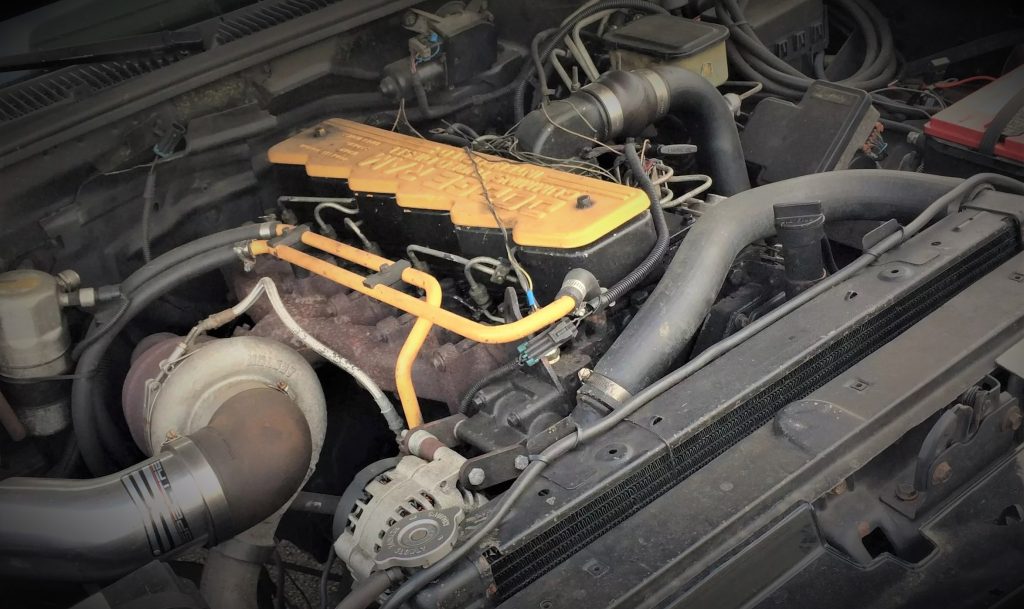
Editor’s note: The 1980s was a transition period for engine technology in America. The iconic carburetor gave way to fuel injection. Cubic inches were out, and liter designations marked a new era for engines — one when power and fuel economy were no longer mutually exclusive. This modern engine age has featured some of the best innovation, technology, and performance yet.
#4 — Cummins Turbo Diesel 5.9L I6
The 5.9L Cummins turbo diesel is the engine that proved a diesel could be viable option for non-commercial trucks and launched the modern turbo-diesel pickup era.
It all started with the 12-valve version:
5.9L 12v Cummins
Cummins introduced the 5.9L, inline-six turbo diesel engine in 1984 to power commercial trucks and agricultural equipment, but the public finally took notice in 1989 when Dodge and Cummins teamed up to mate the 12v Cummins with the ¾- and one-ton Dodge Ram pickup trucks.
Because of its uniqueness and incredible efficiency, it became very popular with light- and medium-duty truck owners, and served as a trailblazer for diesel engine use in non-commercial street vehicles as well as innovations in the diesel aftermarket.
The 359-cubic-inch turbo diesel I6 could double the fuel mileage of many of its gas-powered V8 competitors, particularly under load, and nearly double the torque at low engine speeds.
If the 12-valve I6 has a weakness, it’s the notorious Killer Dowel Pin, a common enough occurrence that most Ram owners of the era know the KDP abbreviation.
A dowel pin pressed into the front of the engine block during assembly has a tendency to back out of its hole over time. This event earned its “Killer” moniker because the loose dowel pin will sometimes wedge itself between the timing gears, which results in horrible things.
The aftermarket has developed KDP kits to alleviate the problem.
The 12v Cummins mill powered Dodge Rams through the 1998 model year, and is probably the most popular Cummins engine ever with Ram truck owners.
But is it the best?
Decide for yourself, but we think its 24-valve cousin might be.
5.9L 24v Cummins
The redesigned 5.9L 24v Cummins turbo diesel debuted in the 1998 ½ mid-model-year Dodge Ram. The 24v Cummins used an electronically controlled Bosch VP44 rotary-type injection pump to deliver fuel through the 2002 model year, and then for 2003 upgraded to a high-pressure rail injection system, enhancing its power potential.
Cummins and Dodge offered a high output 5.9L from 2001-2004 which they mated on to a manual transmission. In 2003, the 5.9L H.O. produced 70 horsepower and 95 ft.-lbs. of torque over the standard option.
The final three years of the 5.9L Cummins turbo diesel were 2005-2007, when emissions regulations prompted the change to the 6.7L Cummins. In the final three years of the 24v Cummins, the workhorse I6 diesel was making 325 horsepower (at 2,900 rpm) and 610 ft.-lbs. of torque (at 1,600 rpm).
From six cylinders.
Awesome.
Specifications
Inline six cylinder turbodiesel 24V
Horsepower – 235-325 @ 2900 rpm
Torque – 460-610 ft.-lbs. @ 1600
Stroke – 4.72 inches
Bore – 4.02 inches
Compression – 16.3:1, 17.2:1
Top Aftermarket Upgrades
According to Summit Racing, these Cummins 5.9L I6 parts are the most readily available:
- Exhaust Systems
- Performance Packages
- Air Intake Kits
- Pinion Bearings and Races
- Clutch Kits
- Air Filter Elements
- Computer Programmers
You can see the current list of our Top Engines of the Last 30 Years here.

[…] lifespan from 1990-95. While it didn’t create an entire movement like the Ford 5.0L or Cummins diesel, it does hold a special place in the hearts of Corvette aficionados. Created just for the […]
I’m having clutch fan problems. Clutch fan doesn’t speed up when the engine goes over 200. I replaced the touch fan and the center on the top of the block but not the center down below where the crankshaft is.. what do I need to do?
On a mechanical fan setup, the fan speed is determined by the engine RPM, and not the temperature of the coolant. Can you clarify what you’ve replaced? Are you talking about the thermostat on the top of the block?
In the meantime, here are a few articles that can help:
* Understanding Fan Clutches — and When it’s Time to Replace Yours
* An Intro to Fan Clutches and How They Work